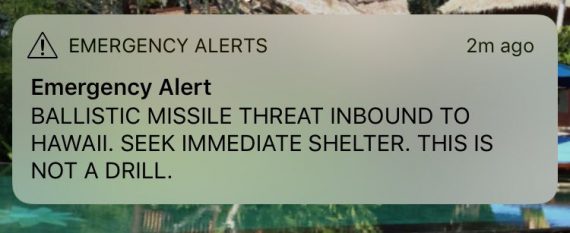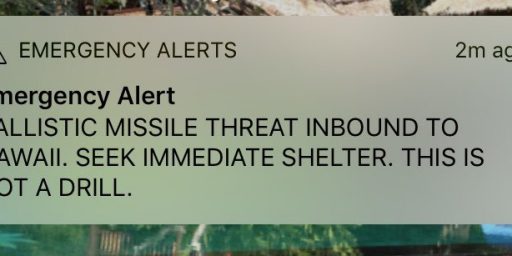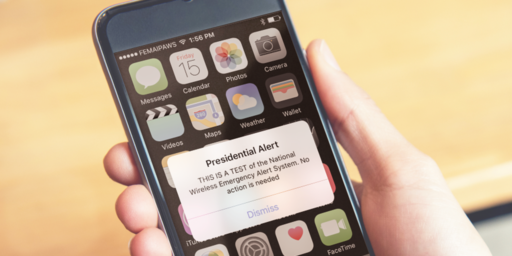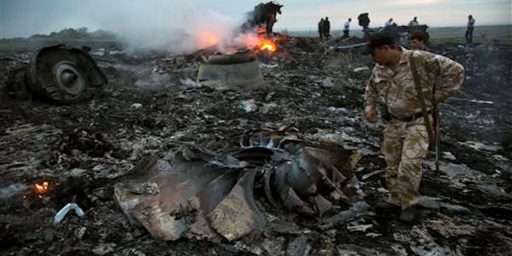False Missile Alert In Hawaii Still Shrouded In Mystery
Two weeks later, it's still unclear what caused a false missile alert to be sent out in Hawaii.
It’s been several weeks since Hawaii was sent into a brief panic after a warning about an incoming missile was sent out in error from the state’s warning system, and it’s still unclear what happened:
WASHINGTON — The Hawaii emergency management services worker who sent a false alert warning of an incoming ballistic missile this month had a long history of poor performance and sent the warning because he thought the state faced an actual threat, officials said on Tuesday.
The mistake, which touched off panic and confusion across Hawaii on Jan. 13, occurred when the worker misinterpreted testing instructions from a supervisor, according to the Federal Communications Commission and state officials in Hawaii.
Believing the instructions were for a real emergency, the worker, who has not been identified, sent the live alert to the cellphones of all Hawaii residents and visitors to the state.
State officials had previously described the episode as an accident. Shortly after it happened, Gov. David Ige blamed the false warning on a state employee who had “pressed the wrong button.”
The Federal Communications Commission and Hawaiian officials have both been investigating the event. The commission investigation, which is continuing, revealed a series of missteps that led to the false alert, including major gaps in Hawaii’s protocol for handling public safety alerts.
The state report was more critical of the employee, who it said had been fired. The investigation found that he had been a “source of concern” for 10 years and had twice before confused drills with real-world events.
In a related development, Vern T. Miyagi, the administrator of the Hawaii Emergency Management Agency, resigned on Tuesday.
Beginning at 8:05 a.m. on Jan 13, the reports say, a midnight supervisor at the agency began an unplanned drill during a shift change. The supervisor pretended to be from the United States Pacific Command in a phone call placed to day-shift workers.
In the call, the supervisor said, “Exercise, exercise, exercise,” as required when tests are conducted. According to the Federal Communications Commission, the supervisor also erroneously said, “This is not a drill.”
According to Bruce Oliveira, the retired Army general who led the state investigation, the message spoken by the shift leader did not adhere to the script outlined in the protocol. “What was actually said in the script was taken from an actual notification,” he said.
But the general emphasized that the shift leader had some “flexibility” and did say “exercise, exercise, exercise” before and after his message. That “tells everybody that this is a practice drill,” General Oliveira said.
Although other emergency management officials in Hawaii understood that the state was conducting a drill at the time, the employee who sent the alert said in a written statement that he had believed there was a real emergency.
The employee then chose from options in a drop-down menu that included test and real alerts. When prompted with the question “Are you sure you want to send this alert?” the employee clicked “yes,” according to the commission.
Panic set in across Hawaii almost immediately, with people furiously contacting members of their family and seeking shelter. The escalating tensions between the United States and North Korea added to the level of concern.
When the employee was directed to cancel the alert to prevent it from going to any phones that had not yet received it, he “just sat there and didn’t respond,” the state report said.
It took about 38 minutes to send a second alert that said the original one was an error. In its report, the Federal Communications Commission faulted Hawaii’s emergency agency for lacking measures to prevent the mistake and to quickly notify the public to disregard it.
Hawaii “didn’t have reasonable safeguards in place,” Ajit Pai, the commission chairman, said.
Michael O’Rielly, a Republican commissioner, said: “It is astounding that no one was hurt.”
The mistake in Hawaii has stoked calls by lawmakers and regulators to improve wireless emergency alerts, which are slowly being updated and will include longer messages and Spanish-language versions starting next year.
The false alarm also exposed some vulnerabilities in the military’s Pacific Command headquarters in Hawaii. On the morning of the alert, the command’s operations center did not have immediate access to the state’s unclassified alert system. Mobile devices are not allowed in the command headquarters for security reasons.
The center did not realize what was happening until military staff frantically called in from outside. Cmdr. Dave Benham, a spokesman for the Pacific Command, said that process had taken only seconds. The command sent out its own message correcting the false alarm.
Commander Benham declined to say what corrective measures the command had taken. Without going into detail, he said the Pacific Command was “using lessons from this event as an opportunity to improve our internal processes as well as coordination with state authorities.”
The Washington Post, meanwhile, reports that the employee in question has been fired:
The Hawaii employee who sent out a false alarm warning of an incoming missile attack earlier this month said he misunderstood that a drill was underway and believed that a ballistic missile had actually been fired at the state, authorities said Tuesday.
Officials also revealed that the errant Jan. 13 alert, which sent waves of panic across the Hawaiian islands, was not the first such mix-up for the employee. At least twice before the false alarm, he “has confused real life events and drills,” a state investigation concluded, part of a troubled work history that had ”been a source of concern . . . for over 10 years” to his co-workers.
The false warning blasted out to cellphones across Hawaii led many residents to fear for their lives at a time of heightened tensions with North Korea and renewed fears of nuclear attacks. Exacerbating the terror, the message blaring “BALLISTIC MISSILE THREAT INBOUND TO HAWAII. SEEK IMMEDIATE SHELTER. THIS IS NOT A DRILL.” went uncorrected for an agonizing 38 minutes.
A federal investigation found that the employee believed there “was a real emergency, not a drill.” That directly contradicts earlier explanations from Hawaii officials, who have said the alert was sent when an employee accidentally hit the wrong button on a computer drop-down menu. A state investigation released Tuesday found that the emergency message was followed by a lengthy period of confusion, during which authorities didn’t immediately know how to correct the alert though they knew it to be false, leaving the public unaware that there was no real emergency underway.
Authorities were apologetic after what Gov. David Ige (D) had previously called “a terrifying day when our worst nightmares appeared to become a reality.” Ige and other officials on Tuesday defended their public response to the false alarm and pledged to continue improving the state’s Emergency Management Agency.
“What happened on January 13th will never, ever be repeated again,” Ige said at a news briefing.
The employee who sent out the alert was fired last week and has not been publicly identified. State officials said his name will be released when any disciplinary appeals are complete.
It was not clear if the employee contested his firing or disputed the public account of what happened. A spokesman for the Hawaii Emergency Management Agency did not immediately respond to a request for comment Tuesday.
The agency’s top official — administrator Vern T. Miyagi — “has taken full responsibility” for the incident and resigned Tuesday, said Maj. Gen. Joe Logan, the state adjutant general, who oversees the department.
The state investigation released Tuesday described the employee who sent out the alert as having a poor history at the agency, with other members of the staff saying they did not feel comfortable with his work. While the employee was counseled and corrected on the spot after previous issues, state officials said, he remained in his position.
The state report describes a frenzy of activity after the false alarm was issued, but even as some employees began notifying others, the employee who sent the alert was “sitting and seemed confused.” Other workers were given mental health counseling after the false alarm, according to the report.
Hours before Hawaii officials released their findings, the Federal Communications Commission published its own preliminary report saying that the state employee claimed to have sent out the alert because he did not realize a drill was underway.
The incident began when a night-shift supervisor decided to test incoming day-shift workers with a spontaneous drill, the FCC report stated. The supervisor managing the day-shift workers appeared to be aware of the upcoming test but believed it was aimed at the outgoing night-shift workers. As a result, the day-shift manager was not prepared to supervise the morning test, the FCC said.
Following standard procedures, the night-shift supervisor posed as a U.S. Pacific Command official and played a message to the emergency workers warning them of the fake threat. The message included the phrase “Exercise, exercise, exercise,” the FCC report said, but it also included the “This is not a drill” language used for real missile alerts.
The worker who then sent the real emergency alert to the public said he did not hear the part of the message declaring that it was an “exercise.” The employee declined to be interviewed by investigators, but he did provide a written statement, the FCC said.
In addition to these revelations, which obviously don’t clear the situation up much at all, it was reported last week that the Governor of Hawaii was unable to send out a message on Twitter when he learned the report was a false alarm because he had forgotten the password to access his Twitter account. That news, of course, doesn’t really explain why he and other state officials didn’t try to use other media channels to inform the public of the truth about the alert until more than a half hour after it had been sent out. Because of this, there have been investigations launched on a wide variety of levels by both state and Federal authorities. As things stand, though, it seems clear that there was a breakdown in the system and what it could mean in the event of an actual emergency.
This is at least the fourth explanation that we’ve heard for what happened on January 13th. Initially, it was claimed that a drill had been running in the middle of a shift change and that the person responsible for the station from which the alert was sent inadvertently sent out an actual warning rather than the internal test that would normally go out during a drill. Shortly after that, it was reported that the error had occurred in the middle of a shift change and that rather than being a drill the system was simply going through the normal checks it does at that time but that the operator of the station in question inadvertently clicked the link to send out an alert. Subsequently, there were reports of a technical flaw in the system that may have led to the false alert. Now we’re being told that the worker in question actually thought there was an inbound missile. The odd thing about this explanation is that the only way the emergency management agency could be informed of an inbound missile would have been via a communication from Pacific Command. There was no such communication according to all available evidence. Where the truth lies is unclear, but given the importance of this alert system to Hawaii as a whole it’s clear that someone will need to get to the bottom of all of this.







I have to ask: If this worker “had a long history of poor performance,” why wasn’t he canned, or at the very least demoted, prior to this?
@CSK: “Lets put him at a job where he can’t screw up, how many alerts do we send anyway”
@CSK :
Better question: why were they in a position to freak out an entire state with the push of a button? Wait, nobody needed someone to fetch coffee or type up a memo?
@Mu:
Apparently he’s been confusing drills with real life for over ten years. Over. Ten. Years.
And just sat there like a dummy when he was told to cancel the alert.
They just need to admit it: he’s stupid. S-T-U-P-I-D, stupid. Dumb, moronic, divorced from reality, off with the fairies, thick as a rock, etc. Never should have been in the building, let alone at that station. Once can be an honest mistake, twice calls into question your ability to understand your job and the world around and three times calls into question how stupid your boss is for letting you still have access to this stuff!!!
He’s somebody’s family, I guarantee it. There’s no way he’s stayed in this job for 10 years after twice mixing up reality and a drill that someone isn’t actively protecting him. That’s why we don’t even have a name yet. He’s unqualified as hell but still is being covered. Watch it turn out he’s somebody’s son or something.
@CSK:
Most government workers at the state and federal level have a lot of built-in protections that prevent them from getting demoted or fired except in extreme cases.
I used to be a federal civil servant and it took 8 months to get someone fired who came to work drunk several days a week. Her supervisor and collegues had to basically ensure she got arrested a couple of times for drunk driving – they’d say, “your drunk, you can’t work today, go home” and when she got in the car and left the cops were waiting for her. So it wasn’t’ coming in drunk that got her eventually fired, it was multiple drunk-driving tickets.
In another case many employees at another organization were caught doing time-card fraud – they basically reporting working eight hours but only worked 4-6 hours. This fraud had gone back years. Out of the 50 people who engaged in various levels of this fraud only two were put on administrative leave – paid leave. When I left they’d been in that status for over a year – collecting paychecks while not working at all while the system figured out what to do with them.
Many federal workers, for example, don’t fall under an evaluation system – meaning there is no requirement to document performance or conduct periodic performance reviews that go on a permanent record.
I can’t really speak for state employees, but the federal civil service system is long overdue for reform in many areas. My sense from talking to state employees is that the problems there are even worse.
Let’s not debate the theory of causes. Hawaii’s system had inadequate controls.
There have been many versions that conflict and do not make sense. Here are some possible theories:
A test to check communications, preparedness, and people’s reactions.
Some sort of missile or unidentified craft actually did enter the airspace and either crashed or disappeared.
I read that another sort of warning occurred in Japan.
For obvious reasons what really happened will not be revealed.
See: “Kecksburg, Pennslvania” incident as to how these things were dealt with in the past.
@Tyrell:
A missile was launched from a Hydra base in southern China – fortunately S.H.I.E.L.D. intercepted it.
@Andy:
Thank god thumbs up are back – you deserved that one!
@Andy: That would make a great episode.